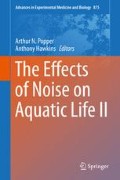Abstract
The use of passive acoustic monitoring (PAM) around marine developments is commonplace. A buffer-based PAM system (e.g., C-POD) is a cost-effective method for assessing cetacean acoustic presence. Devices have been deployed by Sea Mammal Research Unit (SMRU) Marine around the United Kingdom, allowing an examination of the performance of C-PODs with respect to background noise, tilt angle, and environmental factors. C-PODs were found to often only monitor for a few seconds of each minute, resulting in significant loss of monitoring time. Issues were likely driven by environmental and deployment factors. The practical limitations of buffer-based PAM systems in high-energy/noisy environments are indicated here.
Access this chapter
Tax calculation will be finalised at checkout
Purchases are for personal use only
References
Akamatsu T, Teilmann J, Miller LA, Tougaard J, Dietz R, Wang D, Wang KX, Siebert U, Naito Y (2007) Comparison of echolocation behavior between coastal and riverine porpoises. Deep-Sea Res Pt II 54:290–297
Bailey H, Corkrey R, Cheney B, Thompson PM (2013) Analyzing temporally correlated dolphins sighting data using generalized estimating equations. Mar Mamm Sci 29:123–141
Booth CG, Embling C, Gordon J, Calderan SV, Hammond PS (2013) Habitat preferences and distribution of the harbour porpoise Phocoena phocoena west of Scotland. Mar Ecol Prog Ser 478:273–285
Brandt MJ, Diederichs A, Betke K, Nehls G (2011) Responses of harbour porpoises to pile driving at the Horns Rev II offshore wind farm in the Danish North Sea. Mar Ecol Prog Ser 421:205–216
Carlström J, Berggren P, Tregenza NJC (2009) Spatial and temporal impact of pingers on porpoises. Can J Fish Aquat Sci 66:72–82
Chelonia (2013) C-POD.exe: a guide for users. Available at http://www.chelonia.co.uk/downloads/CPOD.pdf. Accessed 1 Aug 2013
Dähne M, Gilles A, Lucke K, Peschko V, Adler S, Krügel K, Sundermeyer J, Siebert U (2013) Effects of pile-driving on harbour porpoises (Phocoena phocoena) at the first offshore wind farm in Germany. Environ Res Lett 8:025002
Hammond PS, Berggren P, Benke H, Borchers DL, Collet A, Heide-Jørgensen MP, Heimlich S, Hiby AR, Leopold MF, Øien N (2002) Abundance of harbour porpoises and other cetaceans in the North Sea and adjacent waters. J Appl Ecol 39:361–376
Panigada S, Zanardelli M, MacKenzie M, Donovan C, Melin F, Hammond PS (2008) Modelling habitat preferences for fin whales and striped dolphins in the Pelagos Sanctuary (Western Mediterranean Sea) with physiographic and remote sensing variables. Remote Sens Environ 112:3400–3412
Pirotta E, Matthiopoulos J, MacKenzie M, Scott-Hayward L, Rendell L (2011) Modelling sperm whales habitat preference: a novel approach combining transect and follow data. Mar Ecol Prog Ser 436:257–272
R Core Development Team (2006) R: a language and environment for statistical computing. R Foundation for Statistical Computing, Vienna. Available at www.R-project.org
Todd VLG, Pearse WD, Tregenza NJC, Lepper PA, Todd IB (2009) Diel echolocation activity of harbour porpoises (Phocoena phocoena) around North Sea offshore gas installations. ICES J Mar Sci 66:734–745
Verboom WC, Kastelein RA (1997) Structure of harbour porpoise (Phocoena phocoena) click train signals. In: Read AJ, Wiepkema PR, Nachtigall PE (eds) The biology of the harbour porpoise. De Spil Publishers, Woerden, pp 343–363
Zimmer WMX (2011) Passive acoustic monitoring of cetaceans. Cambridge University Press, Cambridge
Acknowledgments
Many thanks to those who contributed reviewer comments in the preparation of this manuscript and those who made data available.
Author information
Authors and Affiliations
Corresponding author
Editor information
Editors and Affiliations
Rights and permissions
Copyright information
© 2016 Springer Science+Business Media New York
About this paper
Cite this paper
Booth, C.G. (2016). Challenge of Using Passive Acoustic Monitoring in High-Energy Environments: UK Tidal Environments and Other Case Studies. In: Popper, A., Hawkins, A. (eds) The Effects of Noise on Aquatic Life II. Advances in Experimental Medicine and Biology, vol 875. Springer, New York, NY. https://doi.org/10.1007/978-1-4939-2981-8_12
Download citation
DOI: https://doi.org/10.1007/978-1-4939-2981-8_12
Publisher Name: Springer, New York, NY
Print ISBN: 978-1-4939-2980-1
Online ISBN: 978-1-4939-2981-8
eBook Packages: Biomedical and Life SciencesBiomedical and Life Sciences (R0)

